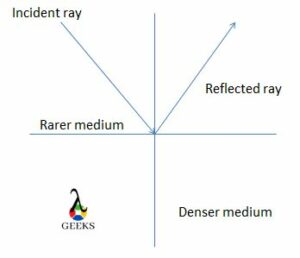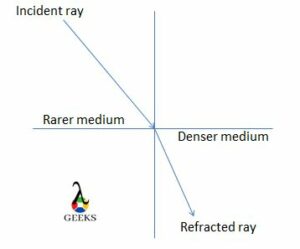What is reflection velocity? The reflection velocity is the one that is present when the light passes from one medium to another.
The reflection velocity is usually described as the light which passes with a particular velocity which is regarded as the magnitude component. This value shall remain the same and does not change under any circumstances.
The wave theory of light explains better the question, what is reflection velocity? It says that light is composed of a set of beams that interfere with one another. There is also another assumption that light is a particle and travels with a particular velocity.
All this discussion can be proved and disapproved with a set of experiments in labs. In order to prove this set of hypotheses, we must conduct experiments from which a conclusion can be drawn.
The conclusions drawn give a better platform to discuss the various other factors in the traveling of light. The light travels with a velocity that will remain constant always but could be disturbed under extreme conditions.
When a ray of light travels and hits a surface, it either will reflect or refract. Let us consider the light to be reflected. What is reflection velocity, then? The velocity will remain unchanged under this condition even when the direction is altered.
In the coming sections of topics regarding what reflection velocity is, we shall see in detail how, why, when, and what reflection velocity is.

What happens to velocity during reflection?
In a reflecting medium, the velocity will undoubtedly remain the same. The reason behind this process is that the speed of light changes its path in the course of time.
The speed is altered due to the change in direction if the process is said to be refracted. The term reflection is regarded as when a light particle or a wave, when considered hits a surface and travels back.
In this case, the velocity will actually not change its value, and sometimes depending on the source of light, the speed is altered and will lead to refraction. In all ways, possible velocity will be the same in the medium.
Let us uses an example to understand what is reflecting velocity better. Say a pulse of light travels through a vacuum and strikes on a surface. Depending upon the surface, the light pulse will travel back in the same medium but with a change in direction.
The light pulse encounters a change in direction, although the speed aid for the same. When it changes the direction, eventually, there must be acceleration which is possible due to the change in speed. But the value of speed goes unaltered and light pulse travels back in the same medium with only the change in direction.
Why is reflection velocity important?
Reflection velocity is important because it will explain specific properties of optics which is helpful for any kind of light-related experiment.
Basic phenomena where the light ray hits a smooth surface, it will work for a sure bounce back into the same medium with only a change in direction and not speed. Velocity is a vector quantity. It has components, magnitude, and direction.
The magnitude is referred to as speed, and the direction is referred to be the same. So when a source of light with its respective speed hits a smooth or glass surface, it instantly will bounce back into the same medium as the original.
When the light ray or beam strikes a medium or, say, travels from one medium to another, the value of speed and direction will depend on the type of medium it has been traveled to and from.
Say, for example, when the light beam travels from a rare medium that is air to a denser medium like water or oil, the speed is said to be altered along with the change in direction too. There is a reason for such change occurring in the medium.
We call the reason to be refractive index, and the refractive index will determine how dense the medium is and how much it will alter the speed and the direction of light that has been entered into it.
Hence keeping in mind the case of changes in the speed of light, the type of medium and the properties could easily be determined, and this is helpful for several experiments related to light.
Does reflection change the speed?
Certainly, the reflection of a light beam does not change the speed at all. The main reason being is speed is a magnitude component of velocity since velocity is a vector quantity, and it is composed of both magnitude and direction.
When the light beam, if referred to be reflected, the speed will not change, but only the phase will be altered in that case. But in refraction, it is totally different when the speed is considered.
Say if we consider a light pulse passing from a rarer medium to denser medium depending upon the medium the type of medium. It may be air, water, or oil and anything for that case. So if it travels from air to water, the reflection is absent; instead, the refraction process occurs.
If the surface is considered to be glass, the light ray will bounce back into the same with the same angle also. So here, the speed is not altered, but the direction changed. There are so many other circumstances where the speed of light is said to be changed, but actually, it does not.
So from these instances, we draw a conclusion saying the speed is certainly not changed, but only the direction is changed, and the angle is also determined.

Does reflection change the velocity?
Before we know what this means, let’s get the difference between speed and velocity. Speed is the scalar quantity. It has only magnitude, but velocity is the vector quantity that has both magnitude and direction components.
So when we say speed, it is the magnitude component of the velocity. If the light passes or strikes on a medium, depending upon the type of the medium, the speed and velocity will vary accordingly.
Speed does not change in reflection but the direction will, meaning that velocity will change in the medium if reflection occurs. The light reflecting in the same medium will change the velocity. That is, the direction will change, but the speed here is a constant by all means.
Yes, the reflection will change the velocity of the light in terms of direction but not in magnitude. Although it appears to change the speed in the end, it is the direction that will be altered.
How does reflection change the velocity?
Say when a light ray passes from one medium to another, the reflection occurs in a different form, and we call it refraction.
When the light enters another medium from its origin, the speed is altered; that is, it will increase or decrease depending upon the type of medium and the value of the refractive index. So this will decide whether the velocity change or not in any medium a light ray enters.
For instance, when light is considered to be a wave, it will have a beam that interferes with each other. So when the beam touches the surface, if it is smooth, the light will reflect back into the same medium with the same angle but with a different phase.
The process goes like this, if the ray of light is refracted, the beam of light entering the medium will change the direction, either towards or away from the normal. This will also cause the speed to change over the course of time.
But in reflection, there is no such thing called a change in velocity; velocity wholly means the magnitude and the direction. In reflection, only the direction is changed with the same speed; when viewed closer, there seems to be a change in speed, but in reality, it does not.
Why does reflection change the velocity?
We must understand why reflection changes the velocity. There is also the fact that speed on a velocity does not change, but the direction does.
Keeping the fact that direction is changed in a reflection but not the speed, we come to a conclusion that reflection does change the velocity. Here the direction component changes and the magnitude do not change in any situation.
The reason is that incident light rays have different angles at which they will either reflect or refract. This change in direction is sometimes regarded to the term refraction also. So when it hits a target, depending upon the target, it will reflect at a different angle.
Considering all the cases mentioned above, we now come to a conclusion that the direction component of velocity is changed in reflecting keeping the speed a constant, which is the magnitude.
Reflection of the light beam occurs at different angles since the incident beam has varying angles, and this will allow the velocity to change depending upon different scenarios.
Also Read:
- How to find velocity with x and y components
- How to measure velocity in redshift observations
- How to compute velocity in cryogenics
- Average velocity examples
- How to calculate terminal velocity in fluids
- Velocity constant
- How to find velocity with acceleration
- How to measure velocity in optics and refraction
- How can you find acceleration from a velocity time graph
- How to determine velocity in mechanical waves
Hi…I am Keerthana Srikumar, currently pursuing Ph.D. in Physics and my area of specialization is nano-science. I completed my Bachelor’s and Master’s from Stella Maris College and Loyola College respectively. I have a keen interest in exploring my research skills and also have the ability to explain Physics topics in a simpler manner. Apart from academics I love to spend my time in music and reading books.
Let’s connect through LinkedIn